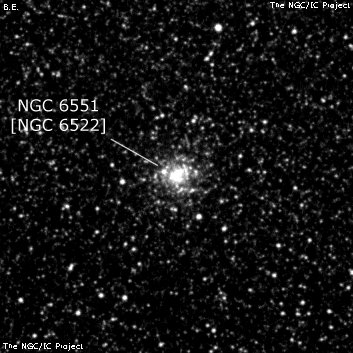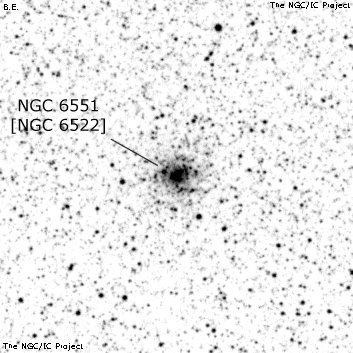NGC/IC Project Restoration Effort
(This is a very very beta version)
NGC6551


Basic Information
Location and Magnitude
Right Ascension: 18:9:0.0
Declination: -29:33:0
Constellation: SGR
Visual Magnitude:
Historic Information
Discoverer: Leavenworth
Year of discovery: 1885
Discovery aperture: 26.3
Observational
Summary description: vF, vS, R, rr
Sub-type: NF
Corwin's Notes
=====
NGC 6551 refers to an object found by Leavenworth in July of 1885. He has
left us a vivid sketch showing what looks like a globular cluster placed
exactly between two moderately bright stars. The position on the sketch cover
matches that published in the AJ list (18 02, -29 34 for equinox 1890), but
there is nothing in the area that matches the sketch. The only other notes on
the sketch besides the position and Leavenworth's initials read, "Drawn July 6
from sketch July 7 '85. Power 500+-." The dates are not mistakes -- the
date "drawn" really does precede the date "sketched." One must be wrong.
Andris and Wolfgang have taken N6551 to be the asterism of half a dozen stars
near Leavenworth's position. But they do not match his sketch at all. The
nearest globular cluster is NGC 6522, and while that might be seen as "vF, vS,
R, rr" at -29 degrees from Leander McCormick, the stars flanking it do not
correspond with those shown on the sketch. The next closest cluster is NGC
6528; its flanking stars are a considerable distance from the cluster, and
there are enough others in the field to make me wonder why Leavenworth
sketched in just two.
Other globulars that might fit are NGC 6293, 6453, and 6624 (all seen through
rich fields), though the flanking stars are conjectural for some of these
clusters. I also checked some of the fainter and smaller clusters (e.g. the
Terzan clusters) using positions from Bill Harris's on-line cluster list
(http://physwww.physics.mcmaster.ca/~harris/mwgc.dat). None seemed reasonable
aside from Terzan 5 -- but again, the flanking stars have to be moved on the
diagram to match the sky.
My own guess, after some digging around on this again in January 2016, is that
Leavenworth saw NGC 6528. Its declination is just thirty arcminutes south,
and the RA is 4 minutes west of Leavenworth's position. NGC 6522 is another
strong possibility, so I've put NGC 6551's number on both objects -- with the
requisite question marks, of course.
So, another mysterious L-M object with no definite identification.



